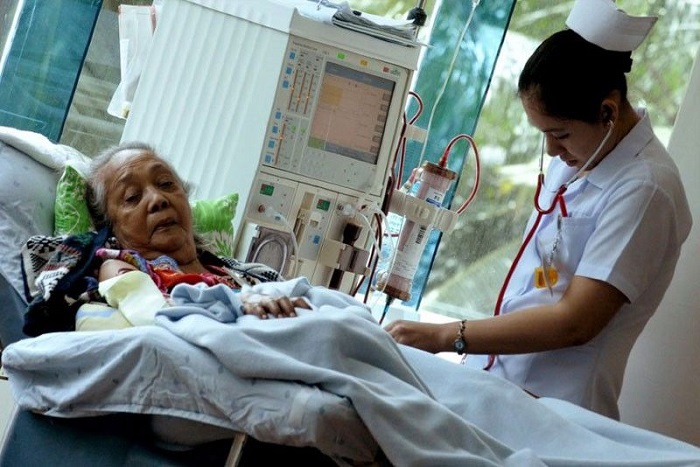More than a decade ago when the Philippine nursing exodus took over the land, where eligible nurses left like a tide. Nurses’ selection for overseas qualification is like a survival of the fittest and each day, the country is losing the most qualified Nightingales in the country.
The Pinoy nurses’ plight over their rights leads to the healthcare crisis we are experiencing today. There is no nursing shortage but rather the lack of interest to work in the Philippines forcing our qualified nurses to go overseas enduring the pain of being away from home. The Philippine Overseas Employment Administration reported an average of 19,000 nurses to leave per year for overseas work. The new millennial trend welcoming the rise of call centers, HMO (Health Maintenance Organization) and healthcare BPO (Business Process Outsourcing) offers an enticing higher pay and incentives with less physically demanding jobs have lure nurses to abandon the four-cornered room of the hospitals and healthcare facilities.

Pinoy nurses demand pay hike for a minimum monthly salary of 30,000 Php entry-level for both government and private hospitals; and a healthy working condition of 1:12 ideal nurse-patient ratio. However, it was reported that the current take-home pay of nurses in public hospitals was ranging from 18,000 to 21,000 only and nurses from private hospitals in the provinces receive lower than minimum wage of about 8,000 and 12,000 per month; and the ideal ratio is hardly true with a back-breaking 1:40 proportion of nurse to patients. A professional with a high level of education, specialized training, and rigorous certification ̶ salary grade 15 is not all that it takes. SG 15 is not enough, there is more than SG 15 we nurses do deserve to claim which should have to be legalized.
The nursing community faced huge discontentment from being long hours overworked and yet underpaid, and on top of this is the minimal benefit claims. Another oppressing condition from inadequately compensated is that these nurses endure exploitation by receiving more than of ideal nurse-patient ratio. If the nurse receives times 3 of the ideal nurse-patient ratio, meaning she is working for 3 staffs so she should be receiving times 3 salary rates as well. Disparate from the Cinderella fairytale, nurses don’t clock off immediately when the eight-hour shift strikes to end, nursing endorsements usually took extra working hours without pay but few minutes late will cost deductions from both monetary and performance evaluation.
The Philippines is not the only country suffering from the nursing shortage and cries over the appropriate nurse-patient ratio. US News & World Report 2019 reported that more than 6,500 nurses across four states in America including Arizona, California, Florida, and Illinois walked out of the hospital for a strike to urge hospitals to expand nursing staff. The New York Times 2019 reported that the nurses on strike complained of a 1:8 nurse-patient ratio in the said four states instead of the expected 1:4. In England, hospitals across NHS are still running with the problem of nurse staffing levels of 8 patients per nurse and are considered understaffed. In RTE news, it was stated that Australia has 1:4-6 nurse to patient proportions while Ireland aims to stay below 1:8 but often reached 1:12-15. In a military hospital in KSA, that is also experiencing nursing shortage has 1:4-6 nurse-patient ratio. Comparing the nurse-patient ratio in other countries, nurses in the Philippines are the most abused healthcare providers around the globe.
Money Talks
From being situated in an oppressing state ̶ nurses begin to dream. The mathematical equation is not complicated, overseas jobs offered 5-10 times more than we can get on patriotism. Philippine nurses opted to work abroad for a shot of greener pasture, better life, and a healthy working condition.
Overseas contract on nurse’s pay scale depends on the number of factors which include: specialty area, type of work, cost of living in the local area, years of experience as a nurse and the level of education. The more credentials you have, the longer the list of incentives and take-home pay you receive. Traditionally, nurses with expertise and higher educational attainment make more than those who do not adhere to continuing education and professional upliftment. Nurses’ salaries vary from the field of specialization because of trends in supply and demand. Also, pay scale depends by shift; a nurse who works during the graveyard shift, weekends and holidays may earn a substantial amount compared to those who attend regular day shifts.
Filipinos are infused with cultures of gifts, perks, and gratuities as signs of being appreciated. In addition to providing decent wages, foreign employers entice nurses who can also offer huge benefits. While medical benefits and vacation leave are standard for full-time employees, some are offering sign-on bonuses, educational benefits, hazard pay, free trainings, and allowances.
Among the three major destinations of Pinoy nurses: United States of America, United Kingdom and Middle East ̶ salaries of registered nurses in the US are among the best in the world, with the national average salary of $75,510 per year as of 2019. Glassdoor 2019 reported that the annual salary of nurses in the United Kingdom is about £27,234. In addition to the competitive salary offered in the UK are the following benefits: 27-33 days paid holidays, paid training, housing allowance, refundable English test and licensure examinations, free flights to the UK, and health pension scheme. Canada offered a well-paid compensation package apart from the basic salary includes leave entitlements, overtime/call back/standby pay, specialization allowances, medical/dental/sick leave benefits, pension plan benefits and employee assistance program. The United Arab Emirates, Sultanate of Oman, Kuwait and Qatar offers a tax-free salary range of P70,000-120,000 monthly with 1 month annual leave. In Saudi Arabia, expatriates are offered with competitive tax-free salary scale according to qualification of about P50,000-85,000 per month, free accommodation, free transportation, annual ticket, free medical care, free trainings, 6 weeks annual leave, 14 days sick leave and paid 7 days emergency leave.
If only our government protects the welfare of our nurses, no great nurse will leave. A few years back when health officials projected that nursing exodus will never cause extinction because there are large numbers of unemployed nurses in the Philippines and schools create thousands of graduates each year. But the effect of this exodus has come, nurses are dropping out of the workforce and have ventured into the BPO industry. Nursing enrollee rates tail-off due to fear of unemployment after graduation. Brain drain upshots as brilliant and hardworking nurses left for overseas jobs with implausible out-turn on the lack of qualified nurses to guide the incoming new generations of nurses. The neophyte nurses will never experience working with the finest exemplar of nurses running the hospital floors resulting in a decline in the quality of the healthcare system.
References:
- Pazzibugan, D.Z. & Yee, J. (2019). DOH Cites Funding Woes: SC says Nurse Entitled to P30,000 Basic Pay. Inquirer.net. Retrieved on 16 November 2019 from https://newsinfo.inquirer.net/1175885/sc-says-nurses-entitled-to-p30000-basic-pay
2.Pamintuan, A.M. (2019). Nurses’ Exodus. PhilStar Global. Retrieved on 16 November 2019 from https://www.philstar.com/opinion/2019/10/28/1963844/nurses-exodus
3.Lardieri, A. (2019). Thousands of Nurses Strike for More Staffing, Better Patient Ratios. US News & World Report. Retrieved on 18 November 2019 from https://www.usnews.com/news/health-news/articles/2019-09-20/thousands-of-nurses-strike-for-more-staffing-better-patient-ratios
4.Ortiz, A. (2019). Nurses in Four States Strike to Push for Better Patient Care. The New York Times. Retrieved on 18 November 2019 from https://www.nytimes.com/2019/09/20/us/nurse-strike.html
5.University of Southampton. (2019). Hospitals Still Running with Nurse Staffing Levels That Put Patient Lives At Risk. University of Southampton. Retrieved on 18 November 2019 from https://www.southampton.ac.uk/news/2019/04/francis-inquiry-study.page
6.Flannery, M. (2019). How much do nurses earn?. RTE News. Retrieved on 18 November 2019 from https://www.rte.ie/news/ireland/2019/0209/1028490-nurses-pay/
7.Al Syoty, W.H. (2014). Health Care System in Saudi Arabia: An Overview on Rural Sector. Retrieved on 19 November 2019 from http://www.mhch.org/Presentations/wedad-ahmed.pdf
8.Paton, F. (2019). Nurse Salary: How Much Do Registered Nurses Make?. NursesLabs. Retrieved on 19 November 2019 from https://nurseslabs.com/nurse-salary/
9.Glassdoor. (2019). Nurse Salaries in United Kingdom. Retrieved on 19 November 2019 from https://www.glassdoor.com/Salaries/uk-nursing-salary SRCH_IL.0,2_IN2_KO3,10.htm
10.Government of Canada. (2019). Salary and Allowances for Nurses. Retrieved on 19 November 2019 from https://www.canada.ca/en/indigenous-services-canada/services/nursing-careers/apply-now-nursing-jobs/salary-allowances.html
11.Sell, S. (2018). 13 Reasons to Work in the NHS as an Overseas Nurse. Medacs Healthcare. Retrieved on 19 November 2019 from https://www.medacs.com/blog/2018/05/10/13-reasons-to-work-in-the-nhs-as-an-overseas-nurse#.XdQ2I1czZ_I









